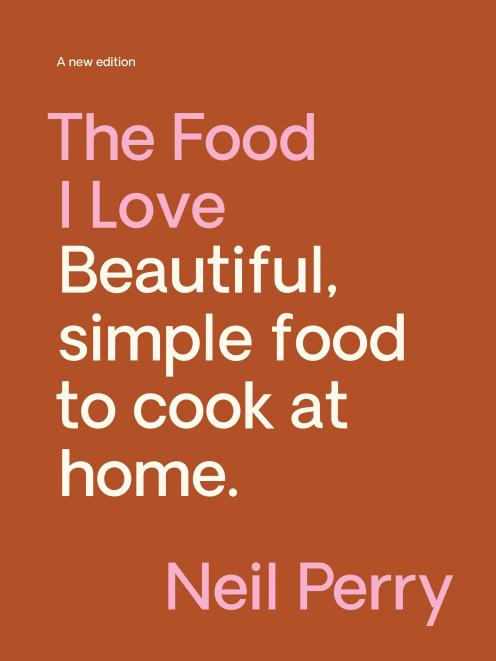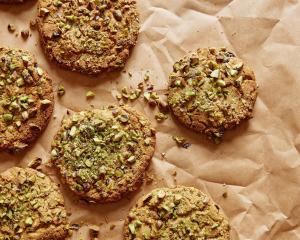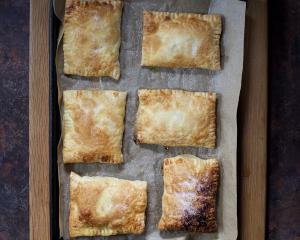
It is one of many in his latest book The Food I Love, a reworking of a cookbook of the same name he published 18 years ago. While many things have changed in that time, Perry, renown for establishing iconic venues such as Rockpool, Rockpool Bar & Grill, Spice Temple, Rosetta and Jade Temple and his food columns, says some things have stayed the same.
"I might be older and wiser, but the way I cook has remained constant. Good shopping is good cooking."
The new book continues to be based on food of the Mediterranean, but revised and refreshed including straightforward advice on everything from holding a cook's knife to trussing a chicken and filleting a fish.
It is Perry’s way of passing on the skills and knowledge that his parents instilled in him growing up. He credits his father, a fisherman and gardener, for the way he cooks and feels about food.
"He taught me to taste, to question, to care for produce and to develop a palate that is the driving force in my life. He instilled an understanding that eating was for pleasure, not for fuel. I learnt that if food was thought about, then it was remembered, and it is this that makes me who I am today."
As a result, the main reason he does what he does is that he is completely committed to sourcing the finest ingredients.
"They are the only ones I am interested in. Why? Because my father was a butcher, a fisherman and a gardener: what a great start in life. But he wasn't just those things, he was the best at those things. He put the very best quality meat on the table, he caught and handled fish well, and he grew superb fruit, herbs and vegetables in the garden."
Over the years his cooking is influenced by the chefs he has worked with as well as the multi-cultural nature of Sydney and the produce that is available.

This latest book has been designed to inspire home cooking at its very best: simple, seasonal and absolutely delicious.
"I have made each recipe a building block, which you have the freedom to use as you like. I have tried to create a book that is of a certain size and thickness, but which allows you to cook hundreds of different dishes from it."
It includes advice such as it is vital to be organized when cooking and that good quality equipment will give cooks a head start. A digital thermometer and a set of accurate scales are also important.
"For instance, cutting is easier if you have good sharp knives."
Perry, who opened restaurant Margaret, named after his mother, in 2021, believes there is quite a few dishes people should be able to produce better than the average restaurant, not because they are difficult, but because they are simple and should be served the moment they are ready, something many restaurants fail to do because of staff or customer constraints.
They include light breakfasts and sandwiches and chapters on seafood, meat, vegetables and desserts.
THE BOOK
Images and text from The Food I Love by Neil Perry, photography by Earl Carter. Murdoch Books RRP $69.99.
 Lamb cutlets with lemongrass and ginger
Lamb cutlets with lemongrass and ginger

When I was growing up, the lamb cutlet was the star of the "meat and three veg" plate that was so famous in the 50s and 60s. A lot has changed since then, but there is nothing I like more than a barbecued lamb cutlet.
Serves 4
Ingredients
12 good-quality lamb cutlets
2 garlic cloves, chopped
2 lemon grass stems, peeled and sliced into fine rounds
3cm piece ginger, chopped
1 tsp sea salt
3 Tbsp chopped coriander (cilantro) leaves
3 Tbsp chopped mint
60ml (¼ cup) extra virgin olive oil, plus extra
freshly ground pepper
lemon wedges
Method
Remove the cutlets from the refrigerator 1 hour before cooking. To make the marinade, put the garlic, lemon grass, ginger and sea salt in a mortar and pound into a rough paste with the pestle. Add the herbs and pound for a further minute, then stir in the extra virgin olive oil and mix together well.
Mix the chops with the marinade and leave for at least 1 hour to infuse. Preheat the barbecue and make sure the grill bars are clean. When hot, put the cutlets on the hottest part. Cook for about 2 minutes on each side for medium rare. Put on a plate and cover with foil. Rest in a warm place for 10 minutes.
Place three lamb cutlets on each of four plates. Mix a little oil with the juices on the resting plate and pour over the cutlets. Give a good grind of fresh pepper, place a lemon wedge on each plate and serve immediately.
Accompaniments
• Barbecued asparagus, potato and mushroom salad would be great with some curry butter just melted over the marinated lamb cutlets.
• Any of the barbecued salads with some pan-roasted or barbecued potatoes would be good. You can use any mayonnaise or any of the butters except the prawn butter. A spoonful of amatriciana sauce topped with the cutlets, would be nice. The other thing that is really yummy is a spoonful of braised Puy lentils, topped with the cutlets and served with a green salad.
 Chocolate cake
Chocolate cake

This is my and my daughter Josephine’s favourite chocolate cake. It has a heavenly texture. It is like a chocolate soufflé – and it behaves like one, as it rises and falls. So don’t freak out as it drops in the middle, because it has no flour to hold it up. It keeps well for two days, as long as it isn’t put in the refrigerator; this will result in it becoming hard and unpalatable.
Serves 10
Ingredients
400g good-quality dark chocolate, broken up
6 eggs, separated
150g caster (superfine) sugar
2½ Tbsp Cointreau
300ml pure (whipping) cream, plus extra, whipped, to serve
Icing (confectioners’) sugar, to serve
Method
Preheat the oven to 175°C. Cut a piece of greaseproof paper to fit a 20cm round cake tin, with a double layer for the side and a single layer for the bottom. Spray the tin with cooking oil and fit the greaseproof paper in snugly.
Melt the chocolate in a stainless steel bowl set over a saucepan of hot water. Don’t let the water in the saucepan boil, as you can scald the chocolate. Remove the chocolate from the heat and allow to return to room temperature.
In a large bowl, beat the egg yolks and two-thirds of the caster sugar until pale and creamy. Add the Cointreau and beat until well combined. Add the chocolate to the egg yolk mixture and stir until completely incorporated, then slowly stir in half the cream. Set aside.
Whip the remaining cream until soft peaks form. Set aside. Start whisking the egg whites in a very clean bowl. When soft peaks start to form, slowly add the remaining sugar and whip until very firm. Fold the whipped cream into the chocolate mixture. Finally, fold in the whipped egg whites.
Pour into the cake tin, put the tin in a bain-marie or on a baking tray and add enough hot water to come about 2.5cm up the outside of the tin. Bake for 45 minutes. Turn the oven down to 150°C and bake for a further 45 minutes. Turn the oven off and leave the cake in the oven for 20 minutes. Cut around the edge of the tin, turn it over on to a plate and the cake should slide out easily.
Cut slices using a knife dipped in hot water and clean the knife after each cut. Place on white plates. Sprinkle with icing sugar and serve with whipped cream.
 Salad of braised beetroot, yam, peas and beans
Salad of braised beetroot, yam, peas and beans

This salad started life as a tagine of vegetables when Sam and I would eat only vegetables for a week, but then I started serving it for friends with chicken tagine or braised meat and Moroccan salads. I’d make it in advance and let it come to room temperature while other things went on the stove. I realized that it tasted better when cool and it made things even easier. Now isn’t that what entertaining is all about?
Serves 4
Ingredients
2 medium beetroots, peeled and quartered
2 small yams, peeled and cut into 4 rounds
2 medium carrots, peeled and cut into 4 rounds
150g baby beans
250ml (1 cup) chermoula (below)
150ml extra virgin olive oil
115 g (⅓ cup) honey
juice of 2 lemons
sea salt
300g (2 cups) shelled peas (this is about 700g of unshelled peas)
8 fresh dates, pitted
80 g (½ cup) blanched almonds
Method
Put the beetroot, yam, carrot and beans in a bowl and loosely coat with the chermoula. Transfer to a tagine or large saucepan that has a lid, set over high heat and add the extra virgin olive oil. Fry, covered, for 2 minutes.
Add enough water to the vegetables to come halfway up their side, then add the honey, lemon juice and some sea salt. Bring to the boil, reduce the heat to a simmer, cover and cook for about 30 minutes. Add the peas and cook for 30 minutes, then add the dates and almonds and cook for another 10 minutes.
Remove the tagine from the heat and bring to room temperature. Serve it in the tagine or, if using a saucepan, transfer the vegetables to a bowl and serve.
Variations
• It is easy to pan-fry some chicken thighs until coloured and cook them slowly with the vegetables to create a delicious meal; just serve with couscous or rice. By the same token, you can add braised lamb or beef, or even add some pieces of fish to the vegetables about 15 minutes before the dish is finished.
• Pumpkin, parsnip, artichokes, fennel or potato can all be used, as can Treviso or radicchio (both types of red chicory), cut in half and cooked for the full amount of time. It all goes soft, melting and slightly bitter. Yum!
Chermoula
Chermoula is the paste that gives Moroccan cooking its great flavour.
I have provided three versions here, but think of them as your servants. You are not a slave to this recipe; it is a movable feast and you are in control.
The first version is the most complex in terms of flavour. The important thing with all three options is to use very fresh spices, so don’t buy large amounts of them. Take these thoughts and experiment with adding different flavours and ingredients, as well as changing the proportions. You can have it hot, full of different spices, or with different herbs.
I sometimes make what I call free-form chermoula; that is, I just chop everything and fry it with the main ingredient; if it is slow-cooking, the flavours will infuse and the texture will be interesting. I add julienne of ginger to some of the dishes and so on.
I also like the flavour of lemon grass in these pastes, as it is aromatic and fresh, like many of the other flavours.
I guess what I’m saying is go for it, experiment and have fun with it. All these flavours go together, so you won’t have a disaster.
As a starting point you should think about this: a simple chermoula could be flat-leaf (Italian) parsley, coriander (cilantro), garlic and red onion. From that simple marinade you can build anything you like.
Chermoula No 1
Makes about 500ml
Ingredients
1 red onion, roughly chopped
4 garlic cloves, roughly chopped
90g (1 bunch) coriander (cilantro), including stalks, washed and roughly chopped
150g (1 bunch) flat-leaf (Italian) parsley, including stalks, washed and roughly chopped
1 heaped tsp sea salt
1 Tbsp ground cumin
1 Tbsp ground coriander
1½ Tbsp ground chilli
1 Tbsp ground turmeric
2 tsp sweet paprika
1 ½ Tbsp ras el hanout
185ml (¾ cup) extra virgin olive oil
juice of 1 lemon
Chermoula No 2
Ingredients
1 red onion, roughly chopped
4 garlic cloves, roughly chopped
70g (½ bunch) flat-leaf (Italian) parsley, including stalks, washed and chopped
40g (½ bunch) coriander (cilantro), including stalks, washed and roughly chopped
1 Tbsp ground cumin
1 Tbsp ground turmeric
1 Tbsp ground chilli
2 tsp paprika
1 tsp sea salt
150ml extra virgin olive oil
juice of 1 lemon
Chermoula No 3
Ingredients
1 red onion, roughly chopped
2 garlic cloves, roughly chopped
150g (1 bunch) flat-leaf (Italian) parsley, including stalks, washed and chopped
90g (1 bunch) coriander (cilantro), including stalks, washed and chopped
1 Tbsp ground ginger
1 Tbsp sweet paprika sea salt
150ml extra virgin olive oil
Method
Put all the ingredients in a food processor, except the extra virgin olive oil and lemon juice.
Process for 1 minute, then slowly pour in the oil until a thick paste forms.
Stir through the lemon juice, if making the first or second version.
If making ahead of time, refrigerate the chermoula until ready to use.










